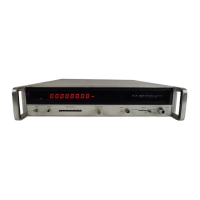Model 5340A
Installation and Remote Programming
followed by the appropriate multiplier to make the reading
Hz,
and
a
word terminator. Table 2
-
5
lists
the order outputed and
a
description of the 16 output characters.
2
-
20.
Bus
Description
2
-
21. The 15
-
line bus consists of
8
data lines plus
7
control and status lines. Addresses, program
and output information are communicated on the data lines. These are based on
a
character
-
serial,
seven
-
bit ASCII code set.
2
-
22.
Three control lines are used to execute the transfer of each byte of information on the data
lines.
They employ an interlocked “handshake” technique to
pass
information. This allows for
asynchronous data transfer without timing restrictions being placed on either the
5340A
or
its
controller.
One line
is
driven by the 5340A to inform the controller of
its
status. The controller
uses the three remaining lines to manage the
5340As on the bus.
2
-
23. Several 5340A’s can be connected to
a
common bus. The exact number depends on the
drive capability of the controller (see LINE CHARACTERISTICS). A specific
5340A
is
made to
send output data (TALK)
or
accept program data (LISTEN) by addressing
it
to do
so.
2
-
24. All bus lines have been given names and mnemonic acronyms that convey the message
being carried on that line. Each line
is
described below, followed by Table 2
-
1 which lists the
relationship of the Attention line and the three handshake lines. Figure 2
-
1 shows the signal
levels and timing relationship of the handshake and data lines.
ALL INSTRUMENTS CONNECT
-
ED TO THE BUS, INCLUDING THE CONTROLLER, MUST OBEY THESE DESCRIPTIONS.
a. SERVICE REQUEST (SRQ)
By setting SRQ low,
a
5340A indicates to the controller that
it
has completed a measure
-
ment and
is
ready to output.
It
drives SRQ only if programmed to “WAIT” in the output
phase of its operating cycle until addressed to output. When programmed in the other
output mode “output ONLY IF addressed”, the
5340A sets SRQ high
at
all times. When
SRQ
is
high, service
is
not being requested.
If two or more
5340A’s are connected to the bus and one of them sets SRQ low, the
controller must go through
a
process of elimination to determine which one requested
service.
It does this by addressing each one to TALK in an orderly manner. Only the
5340A with output information will respond.
b. REMOTE ENABLE (REN)
REN can be used by
a
controller to select remote or local (front panel) control of the
operating of
a
5340A. It works in conjunction with the information stored in the local-
remote program storage cell (see Table 2
-
4). When REN
is
low and the 5340A has
been sent an ASCII
“0”,
it
will
operate according to the information previously stored
in its remote
-
local program storage cells.
It
operates according to
its
front panel con
-
trols for all other combinations of these, i.e., REN
is
low and the remote
-
local storage
cell contains an ASCII
“N”
or when REN
is
high regardless of what
is
stored in the1
remote
-
local cell. ASCII “N”
is
stored in the local
-
remote program storage cell when
either the power is turned on or the RESET pushbutton
is
depressed.
c. INTERFACE CLEAR (IFC)
,I
A controller uses IFC to clear the bus. When it sets IFC low for
>lo0
psec, all 5340A’s
immediately stop driving the data lines (DIO1 through DI07) and handshake lines
(RFD, DAC, and
OAV). IFC will not clear
a
5340A’s service request (SRQ). A con
-
troller may dride IFC low
at
any time. When IFC is high,
it
has no effect on the bus
operation. The
5340A monitors IFC
at
all times.
2
-
3

